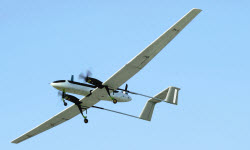Israeli manufacturers are ramping up development of small, unmanned aircraft powered by electric motors and, in at least one case, a hydrogen fuel cell. The UAS are for tactical use and feature advanced payloads and data links, and cover a range of altitudes.
Electric motors have been used on small and micro-UAS, but experts regard the latest versions as breakthroughs in design and function. The advantages of these electric motors are fuel savings, quiet operation, reduced weight and size, and low thermal and noise signatures, which improve UAS stealth and survivability. They are capable of relatively long mission times and high payload capacities.
Special forces are interested in a 65-kg (143-lb.) tiltrotor UAS from Israel Aerospace Industries (IAI). The company developed two models with patented vertical-takeoff-and-landing (VTOL) capabilities. Both designs, Panther and Mini-Panther, have performed test flights and are expected to soon be operational.
Panther combines the flight capabilities of a fixed-wing aircraft with hovering and VTOL, by employing two tiltrotor propellers and a vertical lift augmenter propeller (see photo). This configuration enables Panther to be runway-independent. The concept gives land forces and special operations units capabilities associated with much larger platforms. Each Panther has three electrical motors and sufficient power to loiter on missions of up to 6 hr. at 10,000 ft. The operational radius exceeds 60 km (37 mi.). The UAS carries IAI’s MiniPOP multisensor, electro-optical (EO) day/night payload comprising stabilized cameras, laser rangefinder and a laser designator.
For lower-altitude missions, IAI developed Mini-Panther. Weighing 12 kg, the UAV has endurance of 2 hr. This version carries the miniature Micro-POP EO-stabilized payload. Designed as a portable system, Mini-Panther includes two aircraft and a command-and-control unit that can be carried by two soldiers.
Panther and Mini-Panther are powered by ultra-quiet motors, which contribute to their stealth. The Panthers’ flight-control system is enhanced with automatic-transition flight modes, which control the transition between hovering and forward flight, enabling the UAS to take off and land automatically with a click of the operator console.
Another electric UAS, developed by Aeronautics Defense Systems, is the Micro-Orbiter. With a maximum takeoff weight of 6.5 kg, the flying wing-shaped Orbiter, 1 meter (3.3 ft.) long with a 2.2-meter wingspan, carries a 1.2-kg payload to 10,000 ft., and flies missions of up to 90 min. at 500-2,000 ft. One operator controls the aircraft. It is autonomous throughout its mission, including launch and recovery, and requires minimal training for operation or support. Orbiter has an EO color payload with CCD sensor and 10X optical zoom for daylight operations. An optional night sensor uses a low-light camera. The D-Stamp daylight payload weighs 650 grams (21 oz.). With a low acoustic signature, Orbiter is almost silent. Equipped with an advanced avionics package, GPS and inertial navigation system, and a data link, it provides real-time transmission of imagery from up to 15 km.
Also from IAI is BirdEye 650, a miniature UAS designed and built by the company’s Malat Div. BirdEye performs intelligence, surveillance and reconnaissance (ISR). Flying at 1,000 ft., the aircraft provides operators with real-time intelligence data on enemy combatants. It also executes real-time imagery and transmits it to a portable ground-control system via a satellite communication data link.
The aircraft is powered by an integrated hydrogen proton exchange membrane fuel-cell system called Aeropak, developed by Horizon Energy Systems of Singapore. The system extends flight endurance to 6 hr.—more than double the performance of previous versions powered by lithium batteries. Designed as a drop-in replacement for lithium-polymer batteries used in 5-10-kg UAVs, Aeropak delivers 600 watts of peak power and 900 watt/hr. of net usable energy at less than 2 kg of system weight. It uses hot-swappable cartridges that eliminate the need for battery chargers in the field.
Elbit Systems has tested Aeropak with one of its Skylark I-LE mini-UAVs. A fuel cell-powered Skylark I-LE is expected to provide twice the endurance, delivering 900 watt/hr. of net usable energy per liter of fuel. Simulating battlefield conditions and an actual payload to test the mission performance of the fuel-cell technology, Skylark’s Aeropak-enabled propulsion system has been trialed in a number of scenarios. Tests included repeated takeoffs and hard landings on different terrain to determine the fuel cell’s durability.
Source: Aviation Week

